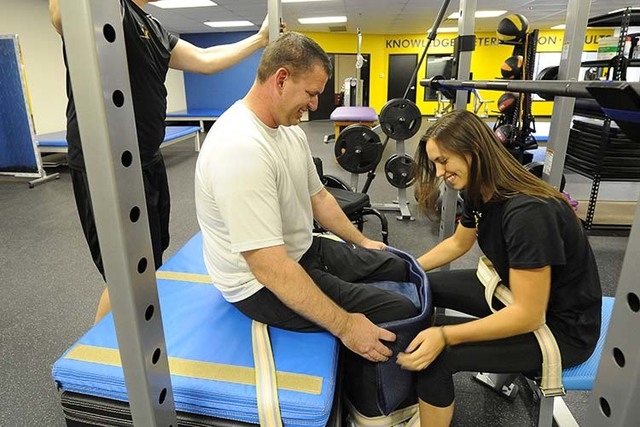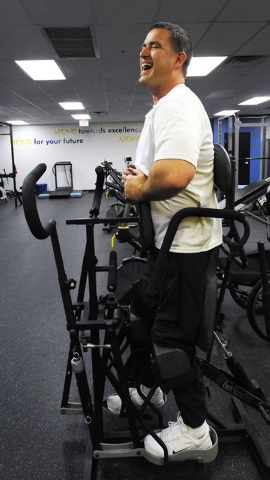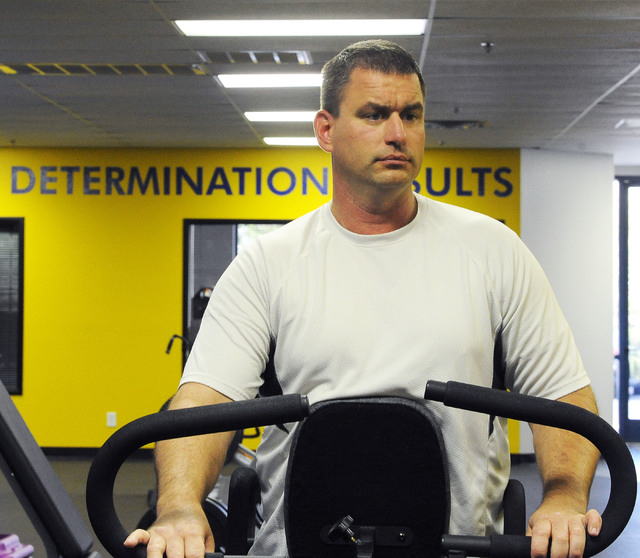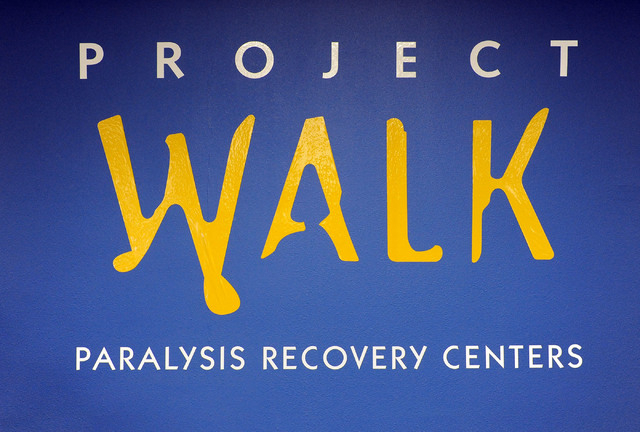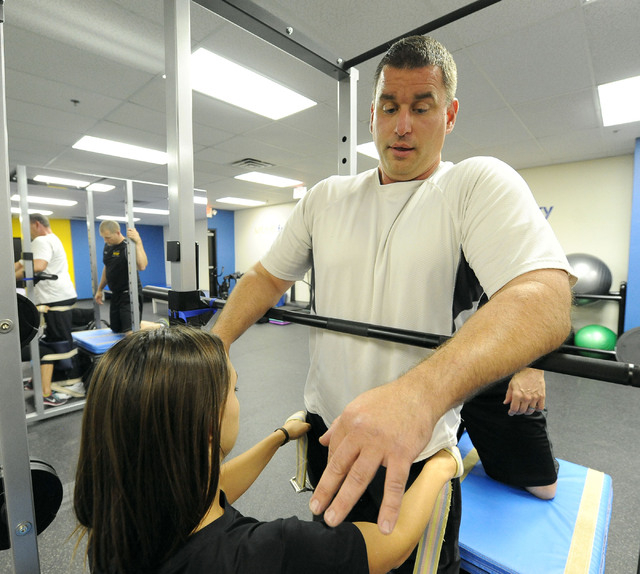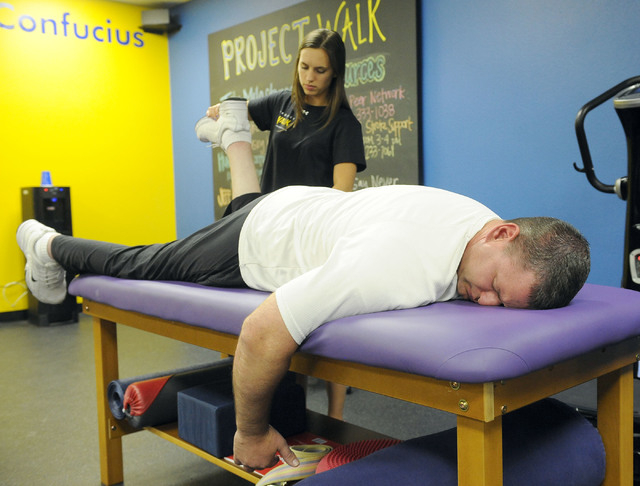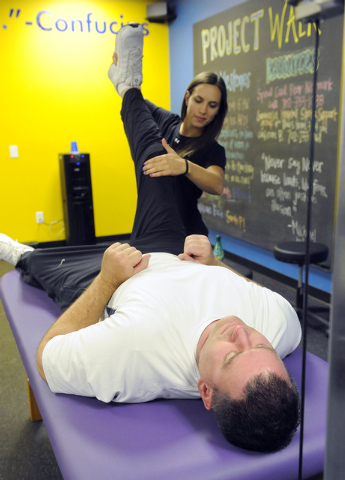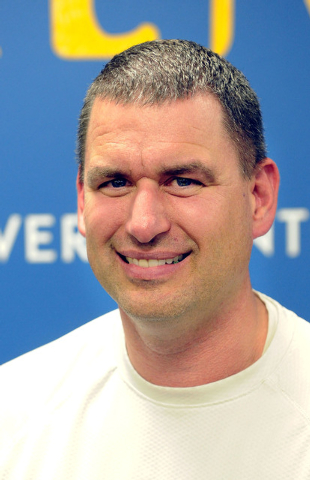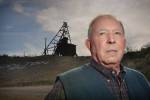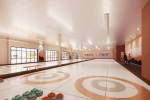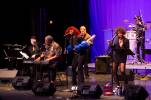Las Vegas facility aims to get patients walking again
Jeff Roch rolls his wheelchair over to the standing frame inside Project Walk while one of the specialists, Hailee Bradford, adjusts the machine.
The equipment straightens Roch’s legs and provides him support throughout the workout. It’s time for another two-hour session to help put him on the path to potentially walking again.
“This always gets me sweating,” Roch says.
Roch was in a motorcycle accident 14 years ago that damaged his spinal cord and left him paralyzed from the waist down. He woke up from a medically induced coma to hear the bad news.
“I remember hearing the doctors, but I couldn’t open my eyes,” he says. “They were saying how I’d never walk again. I understand they were just doing their job. It’s unfair to make that assessment so early.”
Roch always maintained he would walk again one day.
“Even though they aren’t functioning, I’ve always had feeling,” Roch says.
His wife, Stacie Wichman-Roch, says the family always was on the lookout for something that could help Roch.
When a person leaves rehab after the initial injury, she says, there is usually not many options, which was true for her husband.
“Patient therapy is the end of the line,” she says.
While watching the evening news about two years ago, they heard about Project Walk in Carlsbad, Calif.
With nothing to lose, Roch took time off to go through rehabilitation sessions.
“We realized about two weeks into the program that his circulation was improving,” says Wichman-Roch. “His swelling was going down. His bone density was improving.”
Project Walk provides recovery programs for spinal cord injuries and paralysis recovery. It uses activity-based sessions for rehabilitation.
Project Walk, started in 1999 by Ted Dardzinski, was a fluke after a quadriplegic came looking for training.
Whenever Dardzinski would work the man out, he noticed he was having spasms in his muscles. He began using a system called Active Nervous System Recruitment in his rehabilitation.
Three years later, Wichman-Roch says, the man was walking.
Along with spinal cord injuries, Project Walk is now starting to offer services for people who went through strokes or have multiple sclerosis.
The program grew by word of mouth.
“Fast forward 15 years later, and (Project Walk) wanted to start franchising,” she says.
Seeing the product firsthand, Wichman-Roch became the facility manager of the Las Vegas franchise, which opened in March at 365 Pilot Road, near McCarran International Airport.
There are five facilities around the country with three more scheduled to open in the fall.
Seeing the impact the center had on her family’s life made her want to bring Project Walk to Las Vegas.
It would allow her husband to have treatments more often but also offer a much-needed service to the community, she says.
“My vision is actually to break out another facility in Las Vegas,” Wichman-Roch says.
The second facility will be more for locals while the current facility would grow to cater to mostly out-of-state clients.
She sees the added potential of growing medical tourism in Nevada and says a second facility could be five years away.
Project Walk in Las Vegas has two specialist with backgrounds in kinesiology — Bradford and John Weir — plus an aide.
Even if people didn’t end up walking after their time with the program, they have reported anything from improved circulation to overall better quality of life.
Drawing on her own experiences, Wichman-Roch often speaks with groups who have family members with spinal cord or similar injuries.
“My advice would be try it once,” she says. “If you don’t like it, you don’t have to come back. At the very minimum, this is going to improve your quality of life.”
Walking into Project Walk, the facility looks like a cross between a gym and a physical therapist’s office.
Each one-on-one session, every victory, no matter how small, is celebrated.
“Check out our wall,” Bradford says, pointing to a chalkboard full of clients’ progress.
On a Tuesday afternoon, Roch lays on his stomach as Bradford takes his left leg, bends it at the knee for him and has him lower it down.
He takes a deep breath each time, exhaling into the cushion as he tries to will his limbs to respond each time.
“When he first started, he couldn’t even lay flat,” Bradford says.
The exercise is as much mental as it’s physical.
The sessions vary depending on what the client needs, but they are usually there for two hours.
“The first hour is about getting the nervous system excited,” Wichman-Roch says.
In general, people are encouraged to do two to three sessions per week. If they are traveling to Project Walk from another state, people should try to stay for at least a month, she says.
Roch says the hardest part of his journey was in the beginning.
After years in a wheelchair, his body had adapted to that position.
After five minutes walking on the stand frame, Roch moves to the squat rack.
While at a typical gym the equipment is used for people to do squats with weights, at Project Walk the bar is secured and used for patients to practice standing.
Bradford sits in front of Roch, securing her legs to his and gives him a push up so he is standing.
The process goes on for about 10 minutes with breaks here and there for him to sit.
“We try to push the clients to their limits,” Weir says.
Wichman-Roch knows there are many obstacles in getting people to try. Because Project Walk is a nonmedical facility, Wichman-Roch says insurance companies won’t pay for sessions, making it an out-of-pocket expense.
Project Walk is in the process of launching a foundation to help interested people who might not be able to afford services receive treatments.
While some in the medical community are supportive of Project Walk’s methods, some have been more skeptical. But Wichman-Roch says it has worked for her husband.
Roch remains optimistic he will walk again one day. For him, it’s just a matter of when. He wishes he would have had a system like Project Walk earlier in his recovery process.
“I started this years after my injury,” he says.
“Who knows where I’d be now if I had this right after I got hurt.”
Contact reporter Michael Lyle at mlyle@reviewjournal.com or 702-387-5201. Find him on Twitter: @mjlyle.



